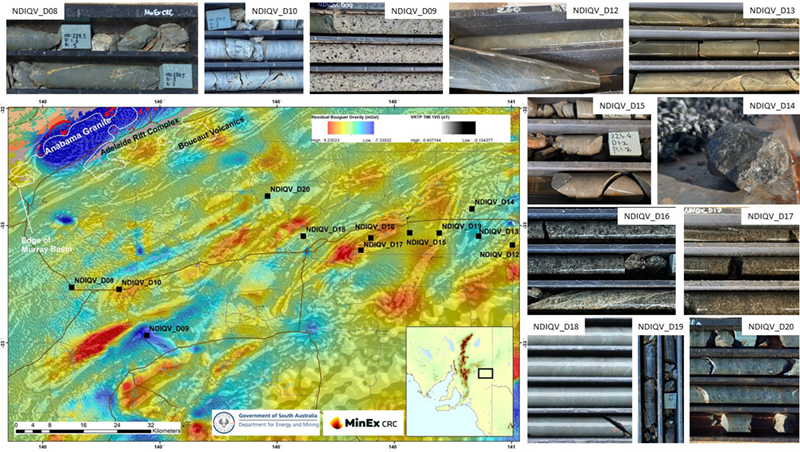Twelve drillholes in the Quondong Vale region have been completed.
The drillholes provide a composite cross-section through each of the geophysical domains across the region. A total of 2.9 km of drilling with the MinEx CRC coiled tubing rig has done a thorough job of characterising the cover stratigraphy on the northern margin of the Murray Basin, as well as the basement rock packages.
About 3 m of basement core has been retrieved for all bar one of these holes. Combining basement core samples with chips through the saprolitic upper basement intersections (and into fresh rock) will allow a stratigraphic interpretation of the basement rocks in the western Loch Lilly-Kars Belt to be built for the first time.
Basement rocks have ranged from coarse-grained intermediate to mafic intrusions, to submarine mafic to felsic lava flows, clastic (meta-)sedimentary rocks to deformed sedimentary breccias, all the way to coarse-grained felsic intrusions (Fig 1). When combined, these rock types paint a picture of a submarine region with large volumes of magma interacting with active structures and rapidly depositing sediments. This is similar in nature to the paleo-environment interpreted for drillholes NDIAW_D05 and NDIAW_D06 in the Alawoona project area.
Figure 1 Basement core samples for the Quondong Vale project area.
Detailed logging and analysis will follow these early interpretations and will progressively be made available on the South Australian Drilling Atlas.
The coiled tubing rig will be used to drill one final hole in the Alawoona project area – NDIAW_D08 which aims to intersect a post-tectonic mafic to intermediate pluton interpreted from regional geophysical imagery. This will complete the 20-hole Delamerian National Drilling Initiative project.
Stand-by for the Alawoona project area to be released for competitive tenement applications under the exploration release area (ERA) process. The Alawoona ERAs will be published in early August 2022, with a 2-week application period in September.
– Tom Wise, July 2022



